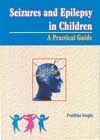|
|
|
Indian Pediatr 2009;46:
76-79 |
 |
Manual of Newborn Care
A Santhosh Kumar
Hyderabad: Paras Medical Publisher; 2008.
Pages 560, Price Rs. 450/-. |
|
T
his book incorporates both a
problem oriented approach as well as a discussion of core and common
topics apart from a drug formulary at the end. The book is conveniently
sized, very well bound and sturdy with an attractive hard cover. The two
color printing, use of color photographs and good quality paper make it
value for the price. The author has made a great effort in covering
virtually everything about neonatal care which may be required by a
pediatrician. Color photographs are of reasonably good quality but the
radiology photographs (X rays, CT scans, nuclear scans) have come out
poorly.
Though the author has consulted and couple of other
experts have reviewed some of the chapters, a single author book on a wide
subject is likely to suffer in this era of ever expanding knowledge and
changing evidence. Numerous ‘facts’ or practices mentioned by the author
suffer from lack of evidence—here the book turns more into a traditional
book based on personal practice and experience rather than scientific and
collective evidence. It would have been useful if the author had given a
bibliography for each chapter and quoted references for the practices.
Inclusion of Intrauterine growth charts and head circumference charts is
lacking even though their use has been advocated in the text. Having a
subject index is a welcome part but it could have been done more carefully
e.g. if you search laryngeal mask airway—you will not find it under "L"
but under "U"— Use of Laryngeal Mask Airway".
Overall, the author needs to be commended for such a
herculean effort to produce a very attractive package almost single
handedly.
Praveen Kumar,
Associate Professor,
Department of Pediatrics,
PGIMER, Chandigarh 160 012, India.
|
 |
Handbook of Sports Medicine for Children and Adolescents
Swati Y Bhave, Dilip R Patel, Donald E Greydanus
New Delhi: Jaypee Brothers; 2008.
Pages 164, Price Rs. 195/- |
|
S
ports medicine and adolescent care
are the new emerging specialties. The book is concise, easy to read,
informative, has good print and is reasonably priced. It provides good
insights to injuries and their management. The book opens up with a
chapter on developmental readiness and evaluation of the child for
participation in sports; followed by a chapter on sports pre-participation
evaluation.
Market is full of costly nutrients, energy drinks and
body building foods, which can fool anyone of us. The truth is that a well
balanced diet can be achieved by eating basic food groups. Chapter on
Nutrition deals with all these aspects. The book also deals with the issue
of use of drugs and supplements to enhance the performance in sports.
Female athletes and their problems are also discussed. Sexual harassments
and abuse by coach can exist not only in girls but also in boys. Coach can
also motivate to give them their best in the sports field. There are
informative chapters on sports psychology, sports and society, sports and
media, sports aggression and basic principles for improving performance.
Besides pediatricians, I also recommend this book for teachers, coaches,
adolescents and their parents.
Subhash C Arya,
Senior Consultant and Chairman,
Department of Pediatrics and
Adolescent Medicine
BLK Memorial Hospital, Pusa Road,
New Delhi 110 005, India.
|
 |
IAP Speciality Series on Pediatric Cardiology
R Krishna Kumar, Shakuntala S Prabhu, M Zulfikar Ahmed
New Delhi:
Jaypee Brothers; 2008.
Pages 320, Price Rs. 395/-. |
|
T
his publication deals with an
important subspeciality of pediatrics. All the chapters in the book have
been written precisely dealing with the most practical things we face in
everyday practice. The introductory chapters on clinical examination,
chest X rays and ECG’s have been written in a simple language and hence
easily understandable. All the congenital heart diseases have been dealt
with in detail including the symptomatology, clinical presentation,
diagnosis and management. The chapter on timing of intervention will be a
useful guide for practicing pediatricians to know when to refer the child
to a pediatric cardiologist for further management. Guidelines for
treatment of Rheumatic fever and Infective Endocarditis have been
summarized well. The chapter on pediatric post-operative intensive care
has highlighted important issues encountered by the intensivist in the ICU
and their management. Various drugs commonly used in pediatric cardiology
have been enumerated with their doses and side effects. The book is very
well illustrated , the quality of pictures being excellent. The
contributors are eminent pediatric cardiologists who have included the
latest concepts and trends in cardiology. I hope this book will provide an
overview of pediatric cardiology to the post graduate students as well as
general practicing pediatricians.
Viresh Mahajan,
C-303, Parsmath Greenville,
Sector - 48, Gurgaon, Haryana.
|
 |
Seizures and Epilepsy in Children – A Practical Guide
Pratibha Singhi
New Delhi:
Noble Vision;2008.
Pages: 280; Price: Rs. 350/-. |
|
T
his book is intended for pediatric
residents, pediatricians and physicians in general practice who need a
practical approach to the diagnosis and management of the various
epileptic disorders of childhood.
There is an extremely useful chapter outlining the
basic approach to pediatric electroencephalography (EEG). Each chapter
ends with a highlighted box indicating key learning points and is followed
by provision of key references and further reading. Probably the only
issue which some readers may find disconcerting is the alteration from
paragraph to bullet point style throughout the entire text. There are a
number of clear and extremely helpful tables, as well as illustrated EEG
panels and diagnostic images. Throughout, there is clarity in description
and management suggestions.
A minor criticism is the lack of specific time
guidelines for initiation of benzodiazepine treatment in febrile seizures.
There is no mention of the use of the sublingual form of lorazepam, which
can be given as an alternative to intravenous or rectal medication. In the
initial assessment period (from 0 to 3 minutes) of status epilepticus,
there is no recommendation to draw anti-epileptic drug levels, if
appropriate.
The chapter devoted to "Management" reviews
anti-epileptic drug treatment and the choice of neuroimaging
investigations. It may have been helpful to re-order the presentation of
the chapter on anti-epileptic drug pharmacogenetics to follow this
discussion (rather than at the end of the book). There is also an appendix
which lists the important and critical questions to be asked on historical
review when a child presents with a seizure – this too may have been more
helpful in the investigation and management chapter. Another concern is
that the management discussion does not include a review of appropriate
metabolic or genetic testing, which should be done for a child presenting
with a seizure, although a subsequent chapter does discuss the genetics of
the childhood epilepsy.
Although this textbook has been written for use in
India and other developing countries, there is sufficient practical
information and a solid algorithmic approach to all elements of childhood
seizures and epilepsy such that this book will be useful in the Americas
and Europe for trainees and pediatric practitioners alike.
Daune L MacGregor,
Professor of Pediatrics (Neurology),
The Hospital for Sick Children,
Toronto, Ontario, Canada.
|
 |
Pediknots
Pediatric Case Studies
KE Elizabeth
New Delhi:
Peepee; 2008.
Pages 443; Price 350/-. |
|
T
his book covers almost all main
fields of pediatrics in the form of case studies. Apart from case
scenarios and discussion, the chapter on importance of pediatric case
recording, vividly narrates the components of an ideal case record. Each
case study comprises a case scenario, discussion on diagnosis,
differential diagnosis, features of management, etc. Salient features to
be discussed are emphasized. The collection of clinical photographs
incorporates common to rare conditions. The language is simple to follow.
The printing is reader friendly and pictures are clear. The case
discussion and compilation of clinical photographs speaks by themselves
about the experience and credential of the author who has put in a lot of
effort in compiling the case scenarios and photographs. The book is worth
possessing by a clinician, especially postgraduates who would get
benefited the most.
K Nedunchelian,
Editor-in-Chief, IJPP and
Assistant Professor,
Institute of Child Health Hospital for Children,
Chennai 600 008,Tamil Nadu.
|
|
 |
Manual of Neonatology
Vineet Bhandari
New Delhi:
Peepee Publishers 2008,
Pages 674; Price Rs. 450/- |
|
T
hough a number of books and manual
exists on neonatology, this book in a manual form stands out as it focuses
only on the common neonatal conditions, written in an easy to read format
in 29 chapters. The author has thus tried to include all possible
conditions in a systemwise format. The radiological images in various
sections and the flow diagrams in the cardiology section add to it. Few
chapters are written concisely (Nutrition in the neonate; fluids and
electrolytes in the newborn; Hypoglycemia in the neonate; Anemia in
neonate; PPHN), while others need considerable inputs for making a uniform
pleasurable reading. The salient points are well covered in most of the
chapters. Addition of few more tables and flow diagrams would have been
more useful in this regard.
Another highlight of this book is an exhaustive account
on neonatal procedures, which covers almost a third of the book.
Publication of this section as a separate hand book would have debulked
the book and given more space to addition of some more neonatal issues
like guidelines to maintain asepsis, CPAP, breastfeeding issues, and
management of IUGR babies which are important to the Indian subcontinent.
Overall, a good attempt to bring another manual that will serve as a
useful handy resource book for practicing pediatricians and residents.
Ashok Deorari,
Division of Neonatology,
Department of Pediatrics,
All India Institute of Medical Sciences,
New Delhi 110 029,
India. |
|
|
 |
|

